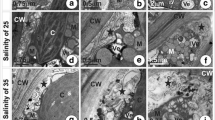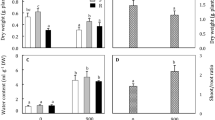Abstract
The investigation of the mechanisms of plant adaptation to stressor action is one of the leading directions of current biological studies. To understand the mechanism of salt tolerance of seabuckthorn (Hippophae rhamnoides L.) and identify its ability to cope with the salinity effect in the saline and extremely cold region of Qinghai, China, a test was conducted with two-year-old seedlings subjected to 0, 200, 400 and 600 mmol·L−1 NaCl solutions for 30 d. The results show that with an increase in salinity, the biomass of H. rhamnoides seedlings clearly decreased. Leaf water potential (Ψ w) and relative water content (RWC) were significantly reduced under salinity, with severe water shortages appearing in leaves. At the same time, the total chlorophyll content declined markedly. When salinity increased and stress time prolonged, the net CO2 assimilation rate (A) significantly declined. Intercellular CO2 concentration (C i) declined at first and was then followed by an increase over the stress time. We conclude that H. rhamnoides grown in the extremely cold and saline region of Qinghai has a certain resistance to salt, which can be planted at appropriate salinity levels.
Similar content being viewed by others
References
Arnon D I. 1949. Copper enzymes in isolated chloroplasts. Polyphenoloxidase in Beta vulgaris. Plant Physiol, 24(1): 1–15
Badr M A, Hussein S D A. 2008. Yield and fruit quality of drip-irrigated cantaloupe under salt stress conditions in an arid environment. Aust J Basic Appl Sci, 2(1): 141–148
Bastías E I, González-Moro M B, González-Murua C. 2004. Zea mays L. amylacea from the Lluta Valley (Arica-Chile) tolerates salinity stress when high levels of boron are available. Plant Soil, 267(1–2): 73–84
Cheeseman J M. 1988. Mechanisms of salinity tolerance in plants. Plant Physiol, 87(3): 547–550
de Azevedo Neto A D, Prisco J T, Enéas-Filho J, de Lacerda C F, Silva J V, da Costa P H A, Gomes-Filho E. 2004. Effects of salt stress on plant growth, stomatal response and solute accumulation of different maize genotypes. Braz J Plant Physiol, 16(1): 31–38
Debez A, Hamed K B, Grignon C, Abdelly C. 2004. Salinity effects on germination, growth, and seed production of the halophyte Cakile maritima. Plant Soil, 262(1–2): 179–189
Ercisli S, Orhan E, Yildirim N, Agar G. 2008. Comparison of sea buckthorn genotypes (Hippophae rhamnoides L.) based on RAPD and FAME data. Turk J Agric Forest, 32: 363–368
Fang Y, Liu D X, Ma Z R, Gu L L, Gong H D. 2005. Tests on the adaptation and salt and alkali resistance of Hippophae rhamnoides L. in sea shore. J Northeast Forest Univ, 33(2): 38–39 (in Chinese with English abstract)
Hasegawa P M, Bressan R A, Zhu J K, Bohnert H J. 2000. Plant cellular and molecular responses to high salinity. Annu Rev Plant Physiol Plant Mol Biol, 51: 463–499
Hoai N T T, Shim I S, Kobayashi K, Kenji U. 2003. Accumulation of some nitrogen compounds in response to salt stress and their relationships with salt tolerance in rice (Oryza sativa L.) seedlings. Plant Growth Regul, 41(2): 159–164
Iqbal R M. 2005. Effect of different salinity levels on partitioning of leaf area and dry matter in wheat. Asian J Plant Sci, 4(3): 244–248
Jaleel C A, Sankar B, Sridharan R, Panneerselvam R. 2008. Soil salinity alters growth, chlorophyll content, and secondary metabolite accumulation in Catharanthus roseus. Turk J Biol, 32: 79–83
Khan M A, Ungar I A, Showalter A M. 2000. The effect of salinity on the growth, water status, and ion content of a leaf succulent perennial halophyte, Suaeda fruticosa (L.) Forssk. J Arid Environ, 45: 73–84
Kim Y, Arihara J, Nakayama T, Nakayama N, Shimada S, Usui K. 2004. Antioxidative responses and their relation to salt tolerance in Echinochloa oryzicola Vasing and Setaria virdis (L.) Beauv. Plant Growth Regul, 44(1): 87–92
Massai R, Remorini D, Tattini M. 2004. Gas exchange, water relations and osmotic adjustment in two scion/rootstock combinations of Prunus under various salinity concentrations. Plant Soil, 259(1–2): 153–162
Mile O, Mészáros I, Veres S, Lakatos G. 2002. Ecophysiological study on the salt tolerance of a pannonian endemism (Lepidium crassifolium (W. et K.)) in inland saline area. Acta Biol Szeged, 46(3–4): 249–250
Munns R. 1993. Physiological processes limiting plant growth in saline soils: some dogmas and hypotheses. Plant Cell Environ, 16(1): 15–24
Neumann P. 1997. Salinity resistance and plant growth revisited. Plant Cell Environ, 20: 1193–1198
Niknam V, Bagherzadeh M, Ebrahimzadeh H, Sokhansanj A. 2004. Effect of NaCl on biomass and contents of sugars, proline and proteins in seedlings and leaf explants of Nicotiana tabacum grown in vitro. Biol Plantarum, 48(4): 613–615
Qin J, He K N, Tan G D, Wang Z L, Chen J. 2009a. Effects of NaCl stress on growth and photosynthetic characteristics of Hippophae rhamnoides and Shepherdia argentea seedlings. Chin J Appl Ecol, 20(4): 791–797 (in Chinese with English abstract)
Qin J, He K N, Zhu Y Y. 2009b. Relationship between photosynthetic physiological characteristics of several common shrub species and soil water content in Hobq Desert of Inner Mongolia, northern China. J Beijing Forest Univ, 31(1): 37–43 (in Chinese with English abstract)
Ruan C J, Xie Q L. 2002. Osmotic adjustment effect of Hippophae rhamnoides L. under salt stress. J Plant Resour Environ, 11(2): 45–47 (in Chinese with English abstract)
Shah A H, Ahmed D, Sabir M, Arif S, Khaliq I, Batool F. 2007. Biochemical and nutritional evaluations of sea buckthorn (Hyppophae rhamnoides L. spp. Turkestanica) from different locations of Pakistan. Pakistan J Bot, 39(6): 2059–2065
Stępień P, Kłobus G. 2006. Water relations and photosynthesis in Cucumis sativus L. leaves under salt stress. Biol Plantarum, 50(4): 610–616
Suárez N, Medina E. 2008. Salinity effects on leaf ion composition and salt secretion rate in Avicennia germinans (L.) L. Braz J Plant Physiol, 20(2): 131–140
Turhan H, Genc L, Smith S E, Bostanci Y B, Turkmen O S. 2008. Assessment of the effect of salinity on the early growth stage of the common sunflower (Sanay cultivar) using spectral discrimination techniques. Afric J Biotechnol, 7(6): 750–756
Woodward A J, Bennett I J. 2005. The effect of salt stress and abscisic acid on proline production, chlorophyll content and growth of in vitro propagated shoots of Eucalyptus camaldulensis. Plant Cell Tiss Org, 82(2): 189–200
Author information
Authors and Affiliations
Corresponding author
Rights and permissions
About this article
Cite this article
Qin, J., Dong, Wy., He, Kn. et al. Short-term responses to salinity of seabuckthorn (Hippophae rhamnoides L.) seedlings in the extremely cold and saline Qinghai region of China. For. Stud. China 11, 231–237 (2009). https://doi.org/10.1007/s11632-009-0039-9
Received:
Accepted:
Published:
Issue Date:
DOI: https://doi.org/10.1007/s11632-009-0039-9




